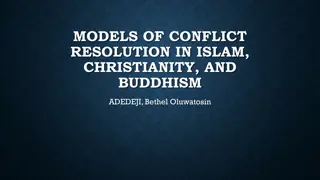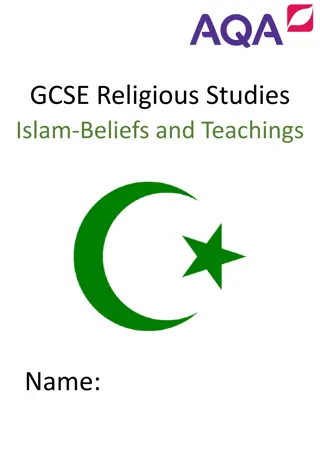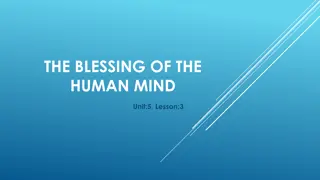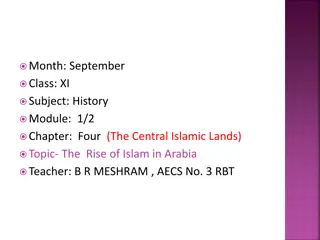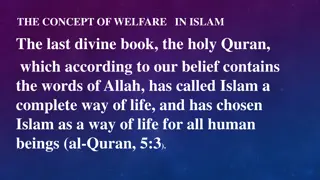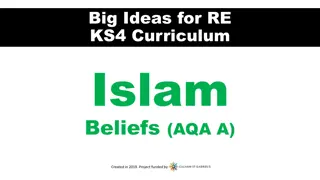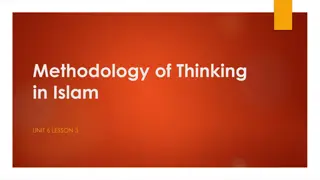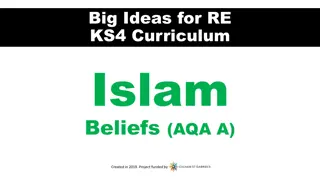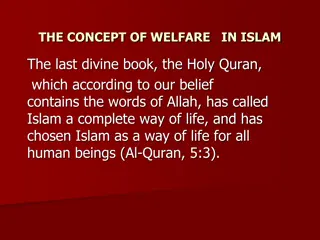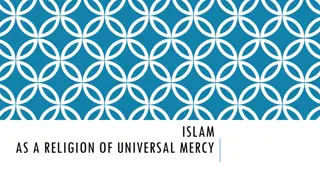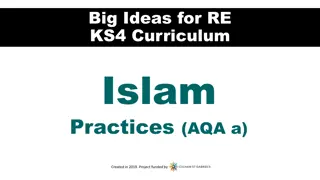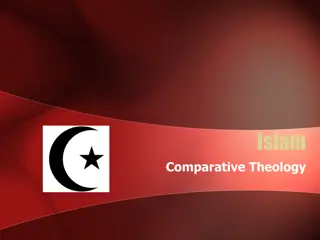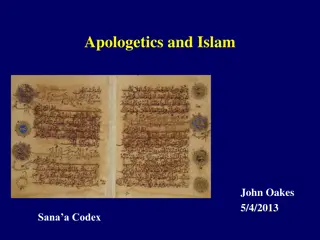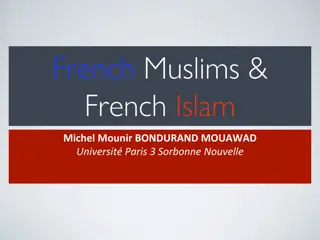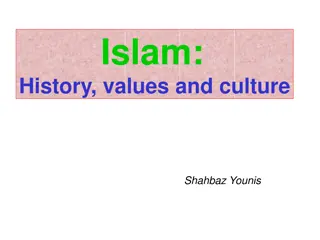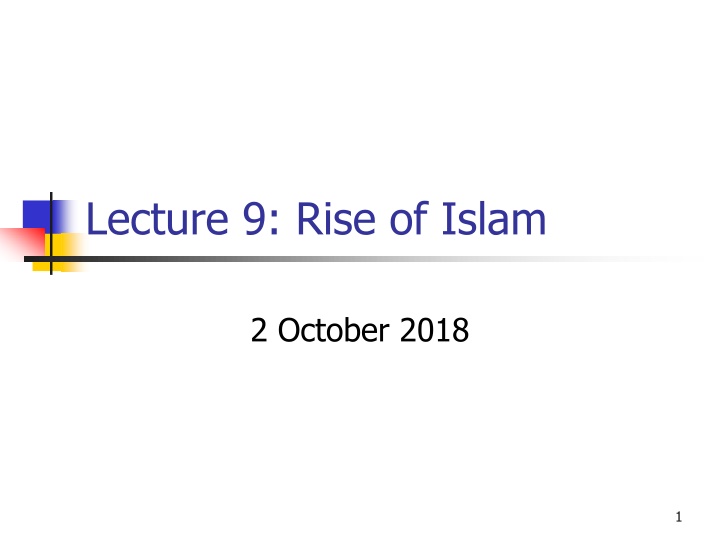
7th Century Historical Overview: Rise of Islam and Byzantine-Persian War
Explore the historical landscape of the 7th century, witnessing the rise of Islam amidst Western and Eastern opposition. Dive into the desolate state of Rome, the political dynamics between the Byzantine Empire and the Arab world, and the consequences of the Persian-Byzantine War. Uncover the complexities of early 7th-century Arabia, a region marked by a diverse religious landscape and tribal conflicts.
Download Presentation

Please find below an Image/Link to download the presentation.
The content on the website is provided AS IS for your information and personal use only. It may not be sold, licensed, or shared on other websites without obtaining consent from the author. If you encounter any issues during the download, it is possible that the publisher has removed the file from their server.
You are allowed to download the files provided on this website for personal or commercial use, subject to the condition that they are used lawfully. All files are the property of their respective owners.
The content on the website is provided AS IS for your information and personal use only. It may not be sold, licensed, or shared on other websites without obtaining consent from the author.
E N D
Presentation Transcript
Lecture 9: Rise of Islam 2 October 2018 1
Introduction Review of historical situation in 7th C Rise of Islam Western Efforts to oppose Islam Eastern Efforts to oppose Islam Review Readings 2
Historical Situation in Early 7th C in West City of Rome is a desolate ruin with poor sanitation and filled with very poor people; under direct authority of Pope Pope St. Gregory the Great rebuilds sanitation and water supply Feeds the hungry Bishops are often the only real source of civic administration and civil justice Monasteries centers of education Irish and Roman missionaries have some success in converting pagan and Arian tribes Visigoths rule Spain; Vandals rule North Africa; Lombards rule northern Italy; Byzantine control of Southern Italy and Sicily, Franks rule Western France; Anglo-Saxons in England; Alamani in Germany 3
Historical Situation in Early 7th C in East Partially unified politically under control of Byzantine Emperor from Egypt to Danube But monophysites in Egypt and Nestorians in Syria undermine religious (and therefore political) unity Primary contact between East and West is through the Pope Nearly all pontiffs spend time in Constantinople during their earlier ecclesial careers Ecclesial authorities are subordinate to civil Eastern Empire will see itself as the continuation of ancient Roman Empire until the fall of Constantinople in 1453 4
Mediterranean at death of Justinian 5
Persian-Byzantine War Early 7th C Extensive warfare between Byzantium and Sassanid Empire 602-628 With support from Jews in Antioch and around Jerusalem, the Sassanid army conquered Jerusalem in 612 Constantinople nearly captured in 626 By 628, Byzantine forces had retaken most of lost territory, including Jerusalem But both Byzantium and Persia left in a weakened political and military situation 6
Early 7th C Arabia Mix Christians, Jews, pagans Ancient pagan pilgrimage site at Mecca Wealthy kingdom of Saba (Sheba) in present day Yemen Ruined by destruction of the Marib dam in 575 AD First dam built c. 1700 BC Tribes of Arabia hostile to each other 7
Muhammad 570 - 632 Muhammad (570-632) Born and raised in Mecca Wealthy trader and merchant Had a series of visions that led to monotheism Opposed by many in Mecca The flight from Mecca to Medina (622) is beginning of Muslim calendar Medina welcomes Muhammad He encourages monotheism Resolves disputes among Arab tribes Founded a religious and political movement aimed at uniting all Arab tribes. 8
Key Points of Islamic Theology Qur an is revealed word of God (must be in Arabic, a translation is not really the Qur an) Islam means submission, specifically submission to will of Allah God is one, no Trinity Mohammed is greatest prophet, although prophets of Old Testament and Jesus are also important Jews and Christians are considered people of The Book Images are an affront to Allah Idolatry is an affront to Allah 9
Key Points of Early Islamic Society Political and military movement to unite Arab tribes in the Dar al-Islam (House of Islam) Opposing Dar al-Islam, is House of War Shari a Islamic Law ; based on Qur an; rules for how the community of Muslims should live Jews and Christians living in Dar al-Islam should be tolerated as long as Pay special tax Do not proselytize Do not foment overthrow of Dar al-Islam Pagans are not tolerated 10
Two Major Branches of Islam After Muhammad dies, the leader of Dar al-Islam is termed the caliph Sunni Caliph should be by a virtuous Muslim who followed the sunna (practice) of Mohammed as recorded in the hadiths (traditions) Authority was with ulama or imam, wise men but not infallible, who preached the Qur an Defense of Qur an through rational argument Shia Caliph should be through the family of Mohammed, first through his son-in-law Ali then Ali s son Hussein Hussein ibn Ali (killed at Karbala in 680), his followers became known as Shia Authority was found in infallible imams as interpreters of the Qur an 11
Five Pillars of Islam (Sunni) Faith (Shahada) Expressed through the fundamental statement of faith: There is no god but Allah, and Muhammad is His prophet. Prayer (Salat) Praying 5 times a day in a prescribed manner Charity (Zakat) All things belong to God, and wealth is therefore held by human beings in trust. Fasting (Sawm) Fasting is especially observed during the holy month of Ramadan. The Pilgrimage to Mecca (The Hajj) 12
Early Islamic Political Leadership First four caliphs, Rashidun, rightly guided Umayyads (Damascus, Cordoba) Abbasids (Baghdad) Fatimids (Cairo) Like Hellenistic kingdoms after Alexander and then the Romans, Arab Muslims found territory too large to rule consistently by one power 13
Early Muslim Expansion in Two Movements Under first four caliphs (632-656) Conquest of Arab tribes in Egypt, Syria and Iraq, including Jerusalem and Alexandria Common cultural background of conquered peoples Early conflict with Byzantine Empire and Sassanid Persian Empire Under Umayyads (692-750) Expansion West and East against non-Arab lands Destruction of Persian Empire Threat to Constantinople Conquest of Latin North Africa, Spain and incursions into France In Ninth C. Muslim armies would conquer (briefly) Sicily, southern Italy, Crete 14
Early Islamic Culture New Capital Cities Damascus, old city but new capital Baghdad Cairo Cordoba Dome of Rock, first great Islamic building, on Temple Mount in Jerusalem, 692 Muslims believe this is the site of Muhammad s night journey Inscriptions are earliest written record from Qur'an Entreats readers to recognize that God is One and not Three Arabic becomes the common language Replaces Greek in Southern Mediterranean, Replaces Persian in Mesopotamia and Iran Replaces Latin in North Africa and Spain as common language 15
Reasons for Arab Military Success Both Byzantine and Persian Kingdoms exhausted from fighting each other Internal unrest in Persia resulting from loss to Byzantines in early 7th C Constantinople has at best contentious control over Mesopotamian (Nestorian) and Egyptian (monophysite) Christians 17
Military Defense Against Muslim Armies Western Cavalry Development of stirrup, molded saddle and armor Stirrup came to Western Europe via Hungary from India Effective edge to Charles Martel and his grandson Charlemagne in battles against Muslims Eastern Greek Fire Naval weapon of exploding incendiary bomb Effective Byzantine edge in early battles for Constantinople 18
Heretical Eastern Theological Responses to Islam Monothelite Controversy (7th C) Christ had one will (divine) Iconoclasm (8th C) Destruction of images Both heresies developed and pushed by Byzantine Emperors to encourage political and military unity 19
Monothelete Controversy Patriarch of Constantinople, Sergius proposes monothelete Christology or that Christ had one will To try to bring Monophysites back under imperial control against Arabs Approved by Emperor Heraclius and his successor, Constans II Pope Honorius (625-638) seems to go along with this Chalcedonian Christology vigorously defended by Maximus Confessor Pope St. Martin I Eventually Eastern Church returns to Chalcedonian formula in Third Council of Constantinople (680) 20
St. Maximus the Confessor (580 -662) Argued forcefully against the monothelite Christology (and its variant, monoenergeria, or one action) Through Christ assuming full human nature meant a full human will and action as well as a divine will and action Strong support for Chalcedonian Christology Attended First Lateran Council in 649 called by Pope Martin I to refute monotheolitism Was persecuted and tortured by Emperor Heraclius Died in exile in 662 21
Pope St. Martin I (r. 649 655) Born in a wealthy Roman family Joined the Order of St. Basil As pope, called the First Lateran Council to refute monothelite Christology Pope Martin was captured by troops of Emperor Constans II and brought to Constantinople as a heretic Branded Tortured Died in exile from his wounds Feast Day 12 November, remembered as a martyr 22
Iconoclast Controversy Byzantine Emperors Leo III (717-741), Constantine V (741-763) Supported image breaking iconoclasm as a way to attract Muslims to Christian orthodoxy Historical Note: Emperor Leo III dropped all military support of Papacy against Lombards, forcing Pope Stephen II into an alliance with Pepin the Short (Charlemagne s father) Monks vehemently opposed iconoclasts St. John Damascene (675-749) Monk at St. Sabas near Jerusalem Strong theological defense of icons Differentiated types of worship and honor Eventually Eastern Church officially embraces honor of icons at Seventh Ecumenical Council, Second Nicene Council (787) 23
Assignments Maximus the Confessor, from Letter II, available at http://www.vatican.va/spirit/documents/spirit _20010328_massimo-confessore_en.html John of Damascus, In Defense of Icons, available at http://www.fordham.edu/halsall/source/johnd am-icons.html 24

